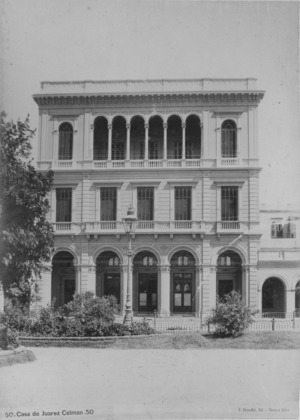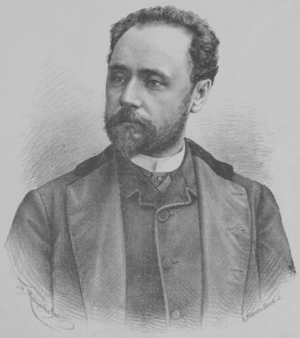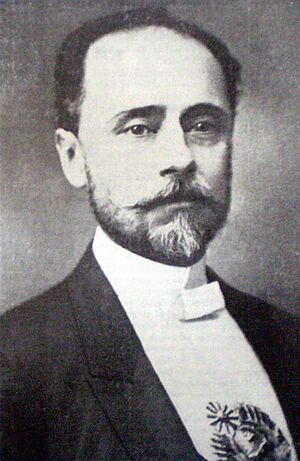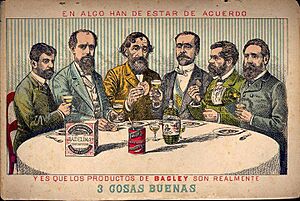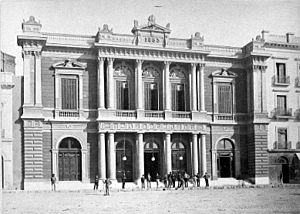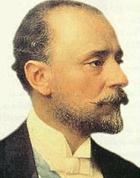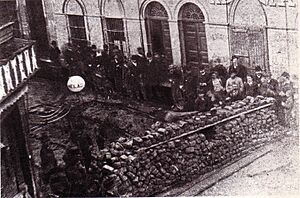Miguel Ángel Juárez facts for kids
Quick facts for kids
Miguel Juárez Celman
|
|
|---|---|
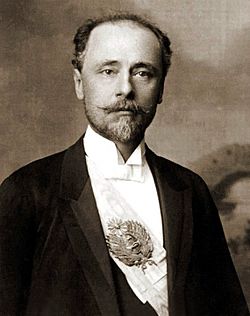 |
|
| President of Argentina | |
| In office October 12, 1886 – August 6, 1890 |
|
| Vice President | Carlos Pellegrini |
| Preceded by | Julio A. Roca |
| Succeeded by | Carlos Pellegrini |
| Governor of Córdoba | |
| In office May 17, 1880 – May 17, 1883 |
|
| Preceded by | Antonio del Viso |
| Succeeded by | Gregorio Gavier |
| Personal details | |
| Born |
Miguel Ángel Juárez Celman
September 29, 1844 Córdoba, Argentina |
| Died | April 14, 1909 (aged 64) Arrecifes, Argentina |
| Resting place | La Recoleta Cemetery Buenos Aires, Argentina |
| Nationality | |
| Political party | National Autonomist Party |
| Spouse | Benedicta Elisa Funes |
| Children | Girls: Rosario, Elisa Clara, Clara Carmen, Eloisa Ignacia, Mercedes Mariana Boys: Miguel Angel, Tomás Antonio, Julio Jorge, Carlos Ricardo. |
| Alma mater | National University of Córdoba |
| Profession | Lawyer |
| Signature |  |
Miguel Ángel Juárez Celman (born September 29, 1844 – died April 14, 1909) was an Argentine lawyer and politician. He served as the President of the Nation from October 12, 1886, until he resigned on August 6, 1890.
His political journey was greatly shaped by his relative, Julio Argentino Roca. Roca helped him start his career in government. Juárez Celman strongly believed in keeping the government and the church separate. He was also a liberal who came from a wealthy family.
As president, he started many public works projects. However, he struggled to keep the country's economy stable. He also faced strong opposition from the Civic Union Party, led by Leandro N. Alem. After a major uprising called the Revolución del Parque, he won against the rebels. But he was still forced to resign and left political life for good.
Contents
Early Life and Political Start
Miguel Ángel Juárez Celman was born on September 29, 1844, in the city of Córdoba, Argentina. His parents were José Marcos Juárez and Rosario Celman. His family was well-known and wealthy, and he became involved in politics at a young age. He studied law and became a lawyer in 1869.
In 1872, he married Benedicta Elisa Funes. Her older sister, Clara Funes, was married to Julio Argentino Roca, who would also become an Argentine president.
After finishing his law studies, Juárez Celman was elected as a deputy in the provincial parliament. There, he worked to make educational institutions separate from religious control. Two years later, he became a senator. In 1877, he was appointed Minister of Government for Córdoba Province.
His strong and knowledgeable work led him to be chosen as a candidate for governor. He was elected by the National Autonomist Party and took office on May 17, 1880.
Governor of Córdoba
When Juárez Celman became governor, there was a rebellion in Buenos Aires. This rebellion was against making Buenos Aires the federal capital of Argentina. The federalization succeeded in 1880. After this, state elementary education was started in the capital. Juárez Celman, along with other governors, helped create the National Autonomist Party (PAN).
This party believed in industrial and civil progress. Juárez Celman was known for wanting to separate the church from government matters. As governor of Córdoba, he started many important projects. These included setting up the Civil Registry, creating rules for burials and city planning, building new schools and hospitals, and setting up farming communities.
His way of governing was very direct. He often got involved in how things were managed and used the army if he faced problems. He believed that asking the public for their opinions often led to mistakes.
Becoming President
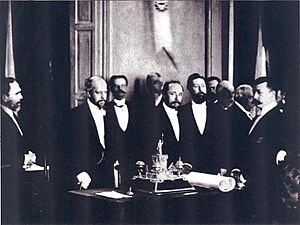
As Governor of Córdoba, Juárez Celman hoped to become the next presidential candidate for the National Autonomist Party. He was close to President Roca and kept up with political events.
There were some doubts about him becoming president because he was only 39 years old when he finished his term as governor. However, Roca supported Juárez Celman's candidacy. Roca believed Juárez Celman was a loyal friend and his brother-in-law.
Juárez Celman ran in the presidential elections on April 11, 1886. He won the election, though there were claims of electoral fraud. This was a common practice by the PAN at the time. Carlos Pellegrini, who had been Roca's Minister of War, became his vice president.
Presidency of Argentina
Juárez Celman became president on October 12, 1886. In his first speech, he spoke about his liberal beliefs. He wanted to improve education, encourage European immigration, and support private businesses. He believed that individuals played a key role in progress. However, his governing style was very strong and centralized. This soon led to disagreements with Roca, who wanted to keep his influence over the government.
What He Did as President
Juárez Celman focused on many public works projects, especially in Buenos Aires. He wanted the city to look like the grand capitals of Europe. He ordered the construction of important buildings like the Central Post Office and the Colón Theater. He also built many schools and improved sanitation systems. He started work on the port of Buenos Aires and the San Roque Dam.
He also greatly encouraged immigration. The government offered free tickets and land to new settlers. Much of this land had been taken from native peoples during the Desert Campaign by his predecessor, Roca. He also pushed for major legal changes. These included organizing the courts, setting up a Property Registry, and passing laws for civil marriage. New codes for mining, criminal law, and commerce were also created.
The "Unicato"
From the very beginning, Juárez Celman's government was known for having a very strong presidency. He held a huge amount of political power himself. Officials were often chosen directly by him. This style of government was called the "Unicato." This name came from his idea of being the "Sole Head" of the Nation and of the National Autonomist Party.
Critics said that the "Unicato" made people lose interest in politics. They felt that the public was too focused on economic growth and didn't care how the government was run.
Economic Changes
Juárez Celman continued the economic boom from the previous government. He sped up the process by selling off many state-owned businesses. He allowed the construction of many new railway lines. One notable sale was the Buenos Aires Western Railway, which was a very successful state company. Its sale was justified by its good performance.
Selling public assets and high spending led to financial problems. But as long as money kept coming in from other countries, the economy grew very fast. Between 1886 and 1890, Argentina's economy grew by an amazing 44%. In the 1880s, 40% of all British money invested abroad went to Argentina. Most of this money was used to build railways, adding 3,800 kilometers of tracks. There were also big investments in ports like Bahía Blanca, Rosario, La Plata, and Buenos Aires.
Farmers and ranchers were doing very well. New farming methods were used, and new lands were opened up. Exports became more varied, including wool, frozen meat, and cereals.
Financial Problems and Crisis
The country's financial situation started to get bad in late 1888. Several banks faced payment problems, and some foreign banks almost went bankrupt. When the Baring Brothers bank realized its mistakes in investing in Argentina's fast-growing economy, money from other countries stopped coming in completely. This started the serious financial crisis of 1890.
Soon after, the Argentine government could not pay its debts. It declared bankruptcy, from which it would only recover years later.
The 1890 Revolution and Resignation
After the economic crisis began, a leader named Francisco Barroetaveña started a group called the Civic Union of the Youth in September 1889. This group later became the Civic Union. Its main leaders included former president Bartolomé Mitre and Leandro N. Alem.
By 1890, many workers went on strike, asking for higher wages. The opposition to the government grew stronger. Juárez Celman's relationship with Roca also worsened. Roca publicly criticized him. On April 13, 1890, a senator revealed that illegal paper money was being printed, causing great public anger.
The opposition decided that elections would not help against the government's power. So, they planned a revolution. The Park Revolution began on July 26, 1890. Rebels controlled a large part of the city of Buenos Aires for three days. However, the rebel military leaders did not take control of the city center. The loyal army fought back, and the rebels surrendered on July 29. Between 150 and 330 people died, and over a thousand were wounded.
Juárez Celman had left the capital during the revolution, forced by Roca and Pellegrini. He returned after the fighting ended. But he had lost almost all support. Roca and Vice President Carlos Pellegrini no longer supported him. The newspapers kept criticizing him, and the economy got worse. On August 6, he resigned from the presidency. Congress quickly accepted his resignation, and Carlos Pellegrini became president. Juárez Celman was the first president in 29 years not to finish his term.
Later Life and Death
After his resignation, Miguel Juárez Celman left politics forever, even though he was only 45 years old. He went back to being a lawyer and managed his family's farms.
He never spoke to Roca again. He blamed Roca for the events that led to his resignation. He also never met with his vice president and successor, Carlos Pellegrini. His only public act was to ask the National Congress each year to review the financial records of his time as president. He wanted to show that he might have been a bad president but an honest one.
Miguel Juárez Celman died on his farm, "La Elisa," in Arrecifes, on April 14, 1909. He was buried the next day in his family's tomb at the Recoleta Cemetery.
Legacy

Because Juárez Celman was the first constitutional president not to finish his term, he was often made fun of. After he resigned, people in Buenos Aires would sing: "¡Y se fue, y ya se fue, el burrito cordobés!" This translates to: "And he left, and he already left, the Cordovan donkey!" People were happy to see a president from outside Buenos Aires leave office, as they blamed him for the country's problems.
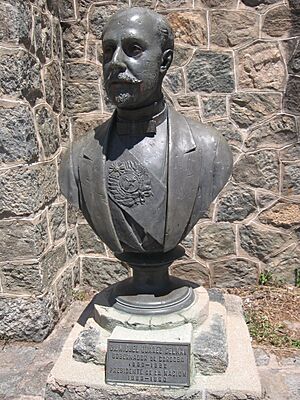
Unlike other presidents, Juárez Celman does not have many tributes. However, there are a few, especially in his home province of Córdoba:
- Juárez Celman Department, Córdoba.
- Estación Juárez Celman, a city in Córdoba.
On Money
His picture appeared on the five thousand austral banknote. This money was used during a time of very high inflation in Argentina from 1989 to 1991.
Images for kids
See also
 In Spanish: Miguel Juárez Celman para niños
In Spanish: Miguel Juárez Celman para niños


